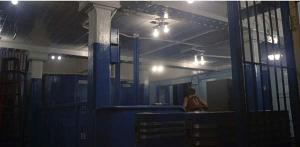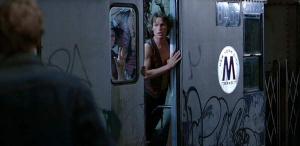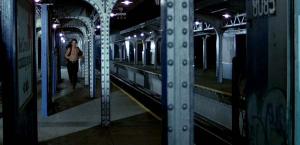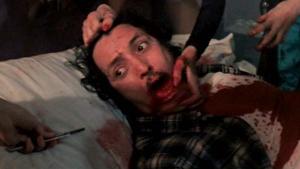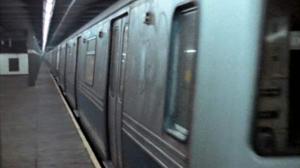Part 2 of a discussion of subways in cinema
The Warriors (1978)
Despite its dodgy reputation and dour advertising campaign which promised an intense and grim experience, Walter Hill’s 1978 gang thriller The Warriors offered an aleatory experience for those who’d expected a balls-to-the-wall violent shocker full of crunched body parts and brutal man-on-man bloodshed. There’s fighting to be sure, and plenty of male posturing, but Hill’s film reveals unexpected pleasures in its vision of New York City as a dystopian gang-infested hellhole; it actually makes the hellhole look sort of fun, recasting its comic book-colorful Manhattan and surrounding boroughs as the stage for a masculine rite-of-passage loosely based on Anabasis, Xenophon’s Greek legend about a small band of warriors trapped in enemy territory. From there, Hill fills the gritty landscape with outrageously stylized gangs with names like The Turnbull AC’s (skinheads in denim who travel in a large bus), the Baseball Furies (mute baseball bat-wielding thugs with faces painted like the band “KISS”), The Orphans (who wear green t-shirts and bluejeans), the Gramercy Riffs (African-American fighters schooled in Chinese martial arts), the Lizzies (an all-female gang who own guns and are paradoxically the worst shots in the world) and the Rogues, who are dressed like late-1970s headbangers with headbands and jean jackets.
The latter are responsible for the murder of Cyrus, one of the primary gang leaders who had attempted to enforce a city-wide truce amongst the gangs in order to consolidate gang control of the city. The Rogues pin the murder on The Warriors, a motley collection of street fighters from Coney Island who sport a vague Native American look (feathers and orange vests).
Unexpectedly the most pronounced emotion of The Warriors is a bittersweet nostalgia for male adolescence; far from the dark, forbidding yarn promised by its advertising campaign, Hill re-imagines Sol Yorick’s novel as a testosterone-soaked fantasia of male bonding, and the macho posturing and numerous street fights resonate on the level of a very intense game of Cowboys-and-Indians. The late-1970s New York City locations become characters in themselves and amongst the up-and-coming cast (which include a pre-Xanadu Michael Beck, an impossibly young James Remar and an early vixenish turn by Mercedes Ruehl) the biggest star is the city’s subway system. 
Pockmarked with graffiti and gloriously dingy, Hill captured all the subway’s grime and glory in its pre-Guiliani era. Not just a backdrop for the film’s events, the subway system provided a arc for the film’s plot as it’s the only means of getting back to Coney Island for the film’s heroes and each subway stop offers a new chance for redemption or harrowing encounters with the city’s other gangs all of whom are gunning for the Warriors. Taking place over a single night and early morning, some of The Warriors’s most memorable moments are set on subway cars, as the destination proves rather less relevant than just surviving the hours till sunrise. Functioning alternately as sanctuaries and proving grounds for the young men traversing its tunnels, the subway stations and platforms in the film are vivid backdrops as the Warriors slowly make their way “home”.
The climax of the film reveals what an amorphous concept “home” is for the young heroes of the film, the empty beaches and desolate streets of late-70s Coney Island looking no more inviting than the rest of the city. There’s more vibrancy and tactile life in the subway, a dangerous but febrile network of tunnels, the agnotic life force to the violent dystopian streets of New York City.
Maniac (1980)
The ghosts of Forty-Second Street porn houses haunt the milieu of William Lustig’s Maniac, and not just because Lustig cut his teeth directing and producing adult films in the mid-Seventies. The grindhouses and porno palaces of Forty-Second Street in the Seventies traded in exploitative and taboo imagery gloriously outside of the boundaries of conventional entertainment. As one of its practitioners Lustig applied many of the principles of porn to the discharge of Maniac’s narrative. Lustig’s crew and some members of the cast were gathered from the adult film industry of the time, included notables such as Gail Lawrence and the iconic Sharon Mitchell who played a small role as a nurse in the precursor to Maniac’s subway scene. The barely-there plot consists of the seedy vagaries of a New York City serial killer named Frank who lives alone in a squalid apartment filled with mannequins and the body parts of his female victims. This threadbare storyline becomes an excuse for a number of grimy, blood-soaked set pieces in which Frank pursues and dispatches the women in startlingly graphic methods (even for the late-Seventies, and even for this particular period in the “slasher” genre). The film is structured much like a porno; the murders in the film are analogously structured like pornographic sex scenes, building up from a protracted tease and pursuit, then a pointedly nasty violation of the victim and a gory release not unlike a sexual climax. The opening of bodies in the film breach taboos similar to sequences in porn, which in the words of Linda Williams in her essay Power, Pleasure, and Perversion: Sadomasochistic Film Pornography, “open the fleshly secrets of normally hidden things”. This is apparent not only in the structure of the film but the milieu: Maniac’s misbegotten Manhattan, consisting of the streets, grimy walkup apartments, dimly lit studios and of course, the subways of late-Seventies New York, form the film’s derelict soul and is the essence of grindhouse at its most ecstatically disreputable.
 In the film, a nurse, getting out of work after her shift, bafflingly refuses a ride and becomes Frank Zito’s quarry after her descent into the subway platform. The pursuit of the nurse into the bowels of the subway station and and her subsequent murder isn’t the goriest scene in Maniac, but it’s a strikingly shot and constructed sequence which configures the subway as a space of jarring schisms and threatening isolation. Lustig and his cinematographer Robert Lindsay’s ever-prowling camera create an unnerving sequence employing the loneliness and attenuating solitude of the subway station and platform.
In the film, a nurse, getting out of work after her shift, bafflingly refuses a ride and becomes Frank Zito’s quarry after her descent into the subway platform. The pursuit of the nurse into the bowels of the subway station and and her subsequent murder isn’t the goriest scene in Maniac, but it’s a strikingly shot and constructed sequence which configures the subway as a space of jarring schisms and threatening isolation. Lustig and his cinematographer Robert Lindsay’s ever-prowling camera create an unnerving sequence employing the loneliness and attenuating solitude of the subway station and platform.  There are production gaffes—the shots of other people standing about the platform are clearly a mistake (the nurse and Frank are supposed to be alone in the station), but even these add to the sense of an unequivocal sense of place; the other passengers might as well be zombies or mannequins in their faceless apathy. The gates and partitions of the subway connote imprisonment, the shots of the iron bars and dividers cut to a staccato cadence (the effectiveness of this scene is more amazing in light of the fact that it was shot surreptitiously, without city permits). This subway-set consecution is harrowing, distilling into less than five minutes the essence of Maniac’s drippy, sweaty, blood-soaked tableau of late-1970s New York City.
There are production gaffes—the shots of other people standing about the platform are clearly a mistake (the nurse and Frank are supposed to be alone in the station), but even these add to the sense of an unequivocal sense of place; the other passengers might as well be zombies or mannequins in their faceless apathy. The gates and partitions of the subway connote imprisonment, the shots of the iron bars and dividers cut to a staccato cadence (the effectiveness of this scene is more amazing in light of the fact that it was shot surreptitiously, without city permits). This subway-set consecution is harrowing, distilling into less than five minutes the essence of Maniac’s drippy, sweaty, blood-soaked tableau of late-1970s New York City.

